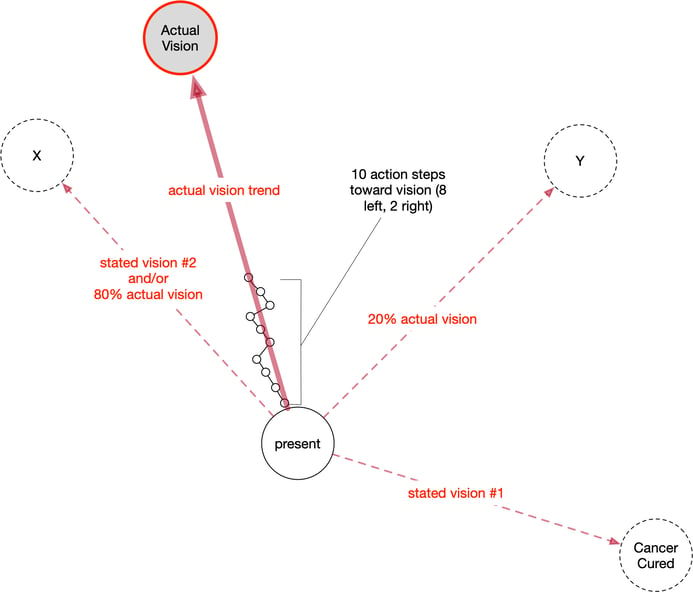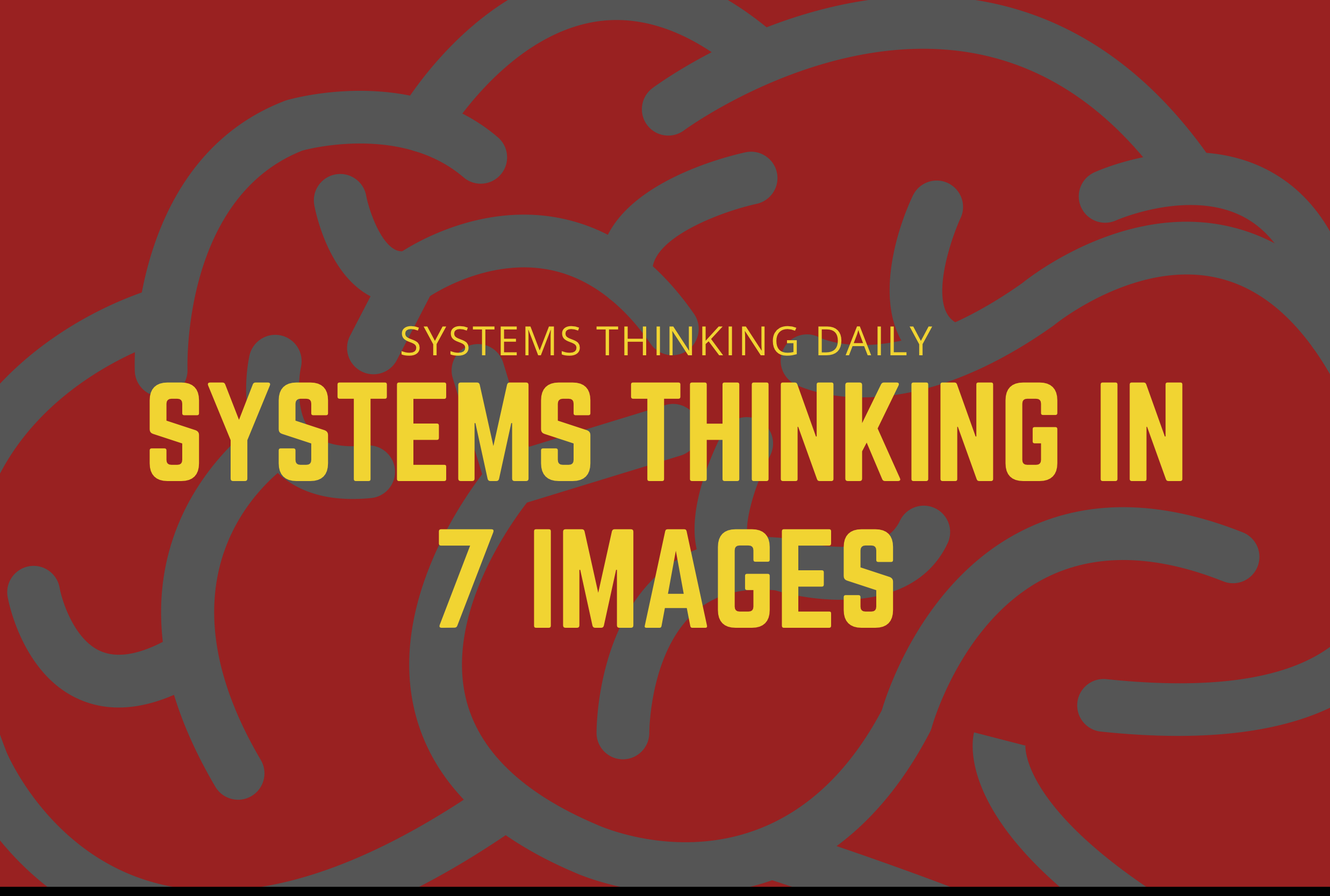Can A Visionless Organization Succeed?
If the right kind of Vision is so important, what explains companies that succeed with no [discernible] Vision? This is an important question we get asked a lot.
Vision is a function of all organizations, whether formalized as companies, or informal groups of people such as protesters. Additionally, "good" Visions adhere to the vision-litmus-checks such that:
- Visions depict a [binary] desired future state;
- Visions are intrinsically motivating;
- Visions are articulated in a short and simple manner;
- Visions are Measurable; and
- Visions lives in the hearts and minds of people (i.e., they are mental models, not "statements"
The litmus tests for Vision are based on the research on effective Visions, with the recognition that a Vision is a functional property of all organizations. In other words, if a company ignores all of these litmus' in creating their stated Vision, that does not mean they do not have a Vision, all systems have a purpose or vision. VMCL Theory suggests that the four universal functions of all organizations (Vision-Mission-Capacity & Learning) exist "in the system" whether you like it or not, whether they are stated explicitly or not, and whether or not the actual functions match the stated functions.
So, how does a company succeed without a Vision? The short answer is that it doesn't. There is always a vision (i.e., Beer's POSIWID), it just may not be well understood or articulated - or more likely the stated vision is not what drives actual behavior of the employees in your organization. Thus, when this is the case, there is another unstated but followed vision at play.
If we look at an organization’s vision depicted in Figure 1, we can say perhaps that there are two stated visions: either "X" or "Cancer Cured." Note that there are two actual visions occurring individually, and therefore statistically, in the organization: "X" and "Y." Most importantly, the actual vision emerges in between ‘X” and “Y” and is identified as the “Actual Vision.”

Figure 1: Actual V. Stated Vision
Another thing VMCL suggests is that Vision is a statistical property of the system. That is, if 80% of the organization is going left towards “X” and 20% of the organization is going right towards “Y” then the Vision for the organization will end up "80%X & 20%Y" of the present position. This is true, even if the organization states on their website that their Vision is "Cancer Cured" or "X"
So the first part of the answer to the question of how companies succeed without a vision, is whether they are aware of it or not, they do have a vision.
The next issue is what constitutes what we mean by "successful." Usually the question people ask is something of the form:
If the right kind of Vision is so important, what explains successful companies with no [discernible] Vision?
Here the term successful is usually used to mean profitable. But if the stated Vision is to Cure Cancer, and I am profitable but have not yet cured cancer, is the company successful? A better definition of success might be to compare the current state of the organization to the articulated goal state. In other words, we can define success as a function of that difference. While some companies are profitable it may not mean they are successful in accomplishing their vision --unless their stated vision was profitability.
The flip side of this issue is that we can ask something of the form:
If the right kind of Vision is so important, what explains profitable companies with no [discernible] Vision based on profit?
This is true of companies whose stated Vision is something other than profitability but end up profitable nevertheless. This can be explained by the fact that profitability is part of the ambient culture and a mental model in companies that is often tied to the agent's (employees) self-interests. As structures made up of individuals who are familiar with the mental model of profitability, an organization need not necessarily state explicitly that they desire to be profitable. Still, the dominant mental model (societally) will help them to be so because it will influence the actual vision.
Often companies may not want to state explicitly that they are all about profit and instead use an externally facing marketing slogan as a proxy for Vision. Yet, if executives each day focus their energies on profit-making activities (Mission), they are communicating that the Vision is about profit by implication. Human agents are intuitive enough and adaptive enough to pick up on this unstated reality, and thereby cause the unstated Vision to emerge.
We must also make a distinction between a vision and a slogan. A Vision is an internally facing statement that if done well can become externally facing marketing. A slogan is an externally facing marketing statement. They are not the same. One of the common fallacies of Visions is that they must be externally facing. The need not be, as they are first and foremost internally-facing.
Thus, when companies with marketing slogans instead of vision statements continue to be financially successful it can lead to several erroneous conclusions such as:
- Visions are irrelevant to success;
- A company may be successful because they have good products, and could be even more successful if they had a proper vision;
- Vision doesn't matter at all, as many managers do when they go through the motions of conventional strategic planning. Here again, what we are seeing is not a case of Visions not being useful-- but of stated stereotypical Vision statements not being useful; and
- One can perhaps also conclude that large companies control the market so strongly that they can get away with poor management practices. Here again, the Vision is profitability. For various reasons, large companies have greater controls over a profitability-Vision. The problem isn't Visions, its transparency.
So, if having a profit-Vision is the key to financial success, then why don't more companies just come out and say it? There are three reasons.
First, customers. Many customers don't want to buy from a company that only cares about its own-self interest and its own financial success. This is especially true in a globalized and interconnected market where customers see the results and inherent value of their purchasing decisions.
Second, employees. Many employees don't want to work for a company that only cares about its own-self interest and its own financial success. This is especially true in a competitive talent market.
Third, social entrepreneurialism. Many entrepreneurs—especially social entrepreneurs—see the entrepreneurial mindset as something that can be used to do much more than build wealth. They see wealth as capacity for solving real-world problems and making the world a better place. They also see—because they are entrepreneurs—that customers like to buy from and talent likes to work for such organizations.
This means that the profitability motive for this new breed of capitalists and entrepreneurs is a necessity and an issue of Capacity (the C of VMCL), rather than of the Vision. In other words, if we are to change the world for the better by bringing about our Vision, we will need the capacity to do so which will require profitability and reinvestment.
In order to answer the question, why do visionless companies succeed, one must first question the question. In other words, the assumption that an organization simply has no vision is erroneous, and the narrow view of success to be synonymous with profitability only leads us down a path of misunderstanding of the very nature of systems, organizations (formal and informal) and their inherent purpose or vision.
.png?width=150&height=150&name=CRL%20GOAT%20Logo%20(4).png)



